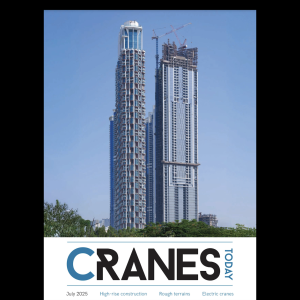Arne Bundgaard Jensen established Højbjerg Maskinfabrik (Højbjerg Engineering) in 1945, naming the company after the Aarhus, Denmark, suburb in which it is based. Jensen started off repairing motorcycles, and moved into building his own equipment a couple of years later. He startied off with agricultural trailers at the request with his farmer brother.
He built his first crane in 1953, and the company now focuses almost entirely on lifting (although it does have a sister company that builds grinding tables, used in metal work). Unlike many loader crane firms, it still makes its own hydraulic cylinders. HMF has a 40% slice of its home market, and around a 10% share internationally.
Over its 60-year history, the company has moved into increasingly bigger locations in Aarhus. Across Denmark, it now has production facilities with a total floorspace of 75,000 sq m. At its Aarhus headquarters, the company has 44,000 sq m available. Currently, the company is building a new 3,400 sq m painting and boom fabrication facility at its headquarters.
In its home market, many of the HMF cranes are sold to users who will hire them out for a range of jobs and applications. Unlike markets such as the UK, where knuckleboom owners generally use the cranes for a single application within their own business, these Danish users want cranes that are as flexible as possible. They often value the ability to move the crane between chassis easily, and to change between hook and muckaway attachments quickly.
The latest additions to the company’s range, shown on the tour, are a series of eight cranes in the 12–17tm class. In the near future, HMF will be upgrading the rest of its product range, which currently extends from 0.5–72tm.
HMF builds each crane to order, and offers a range of options to customers. The eight new cranes are each available in two versions. The ‘single power plus’ version features a dual linkage on the jib, while the ‘double power plus’ version has dual linkages on both the column and jib. HMF recommends the single power plus configuration to users who want a crane that will work particularly well with stretched boom system, at moderate height and at long reach. The double power plus system increases the cranes capacity at higher hook heights.
Customers can then choose how many extensions they want on the jib, with up to eight available. A choice of ten different control configurations is also available.
The new mid range starts at 12.1tm, with the 1300-K1. This single extension version of the 1300 crane can reach a radius of 6.2m. A choice of up to six extensions (designated by the ‘K’ digit after the model number) are available on the 1300. The 1300-K6 has a load moment of 10.1tm. At the other end of the new mid range series is the 1730, with capacities from 16.1tm on the single extension 1730-K1, through to 14.1tm on the six extension 1730-K6.
The company has considered the size and weight of the finished crane throughout the design process. High tensile steel is used for all components, not just load bearing sections, in order to cut the width of the folded crane as much as possible. Hydraulic hoses are run inside the boom and outriggers, further reducing the crane’s profile.
The cranes are designed to be easily maintained. A central greasing nipple gives access to all five greasing points, meaning the operator or maintenance engineer can grease the entire crane easily. High pressure swivel couplings protect the hydraulic system where the crane slews. Maintenance free bushings are used on all of the big swivel joints.






